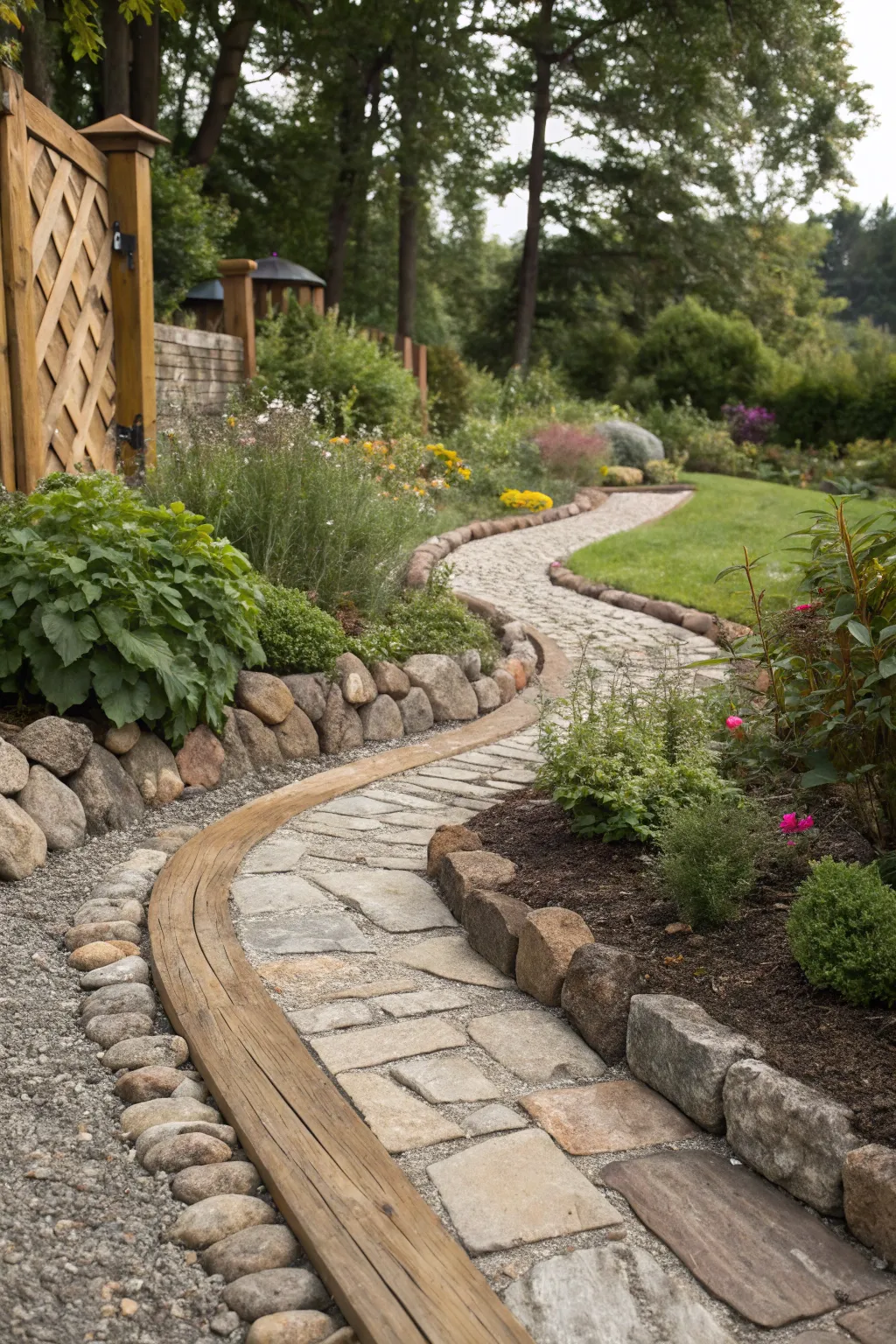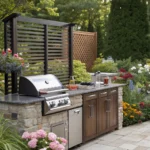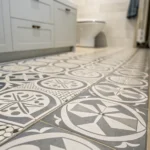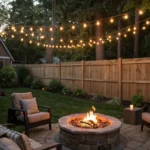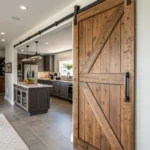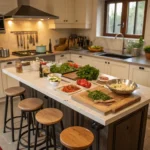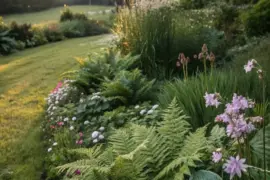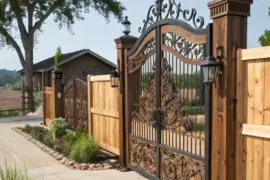Have you ever walked into a garden and thought, “Something’s missing—just a hint of magic, perhaps?” You’re not alone! Whether you’re working with a sprawling backyard or a cozy green nook, the secret ingredient often lies in the details.
Sometimes, all it takes is a fresh perspective—and a little edge—to make your garden dreams flourish. Let me show you how a few thoughtful changes can transform your outdoor space from ordinary to extraordinary.
Log Magic, Timber Charm
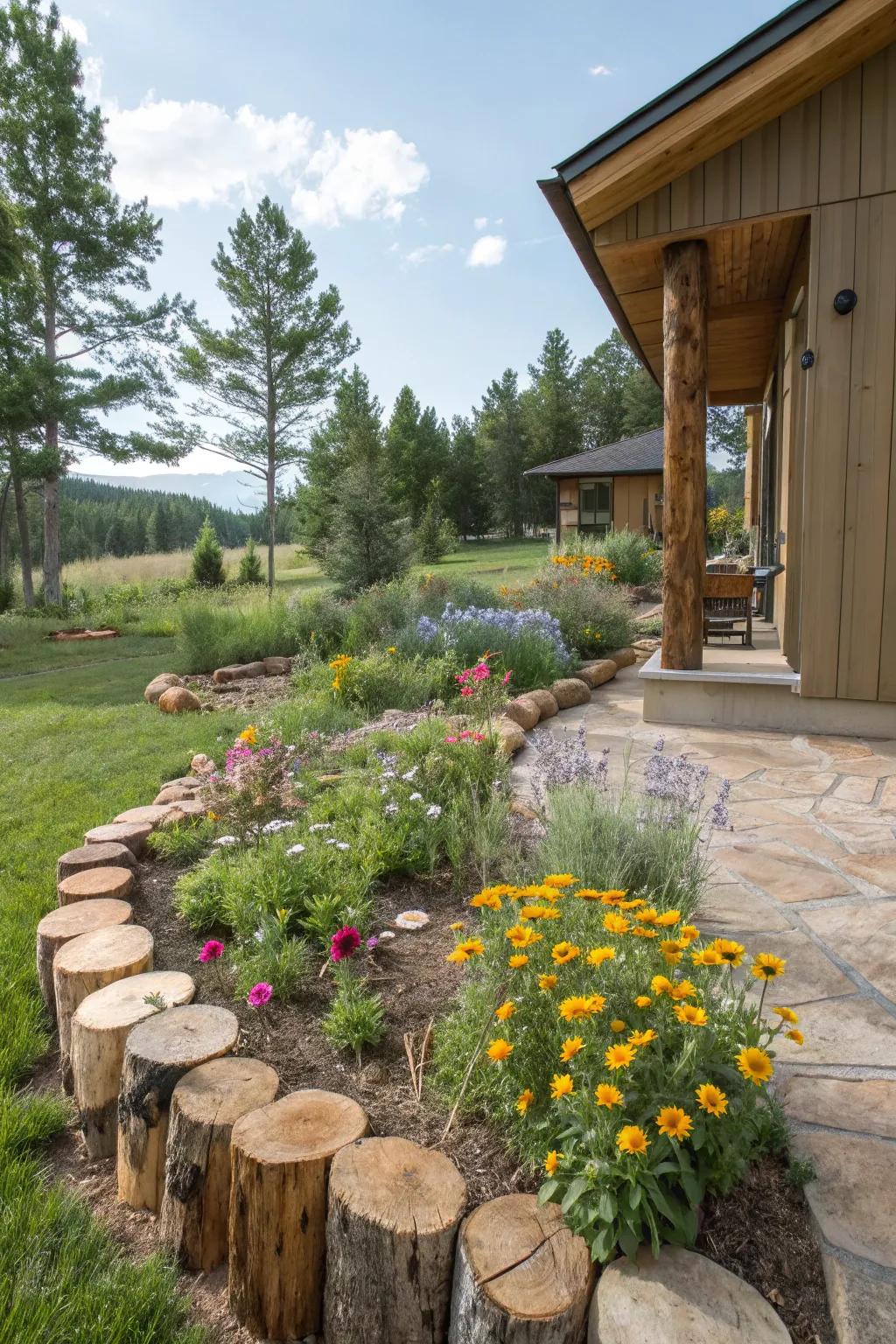
Imagine wandering through a garden where the borders feel like they leapt from a woodland fairy tale. That’s the essence of using log or timber edging—pure rustic charm with a twist of storybook wonder.
Step inside a natural wonderland every time you cross the border of your flower beds.
I once worked with the Harrisons, a family who longed for a garden that encouraged their kids to explore. We edged their wildflower beds with chunky, uneven log rounds and let the moss do its thing. Not only did it look enchanting, but it also kept mulch in place and created cozy nooks for pollinators. For the Harrisons’ shady areas, we used upright timber pieces to guide the eye along winding paths—a perfect blend of whimsy and function.
Looking to try something new with timber edging? Here are three creative ways to spin this classic:
- Create semi-circular seating spots around the base of trees.
- Use logs of varying heights for a playful, uneven border.
- Add gaps between logs for mini-wildlife highways—frogs, beetles, and friends will thank you!
Explore these options:
Where Path Meets Border?
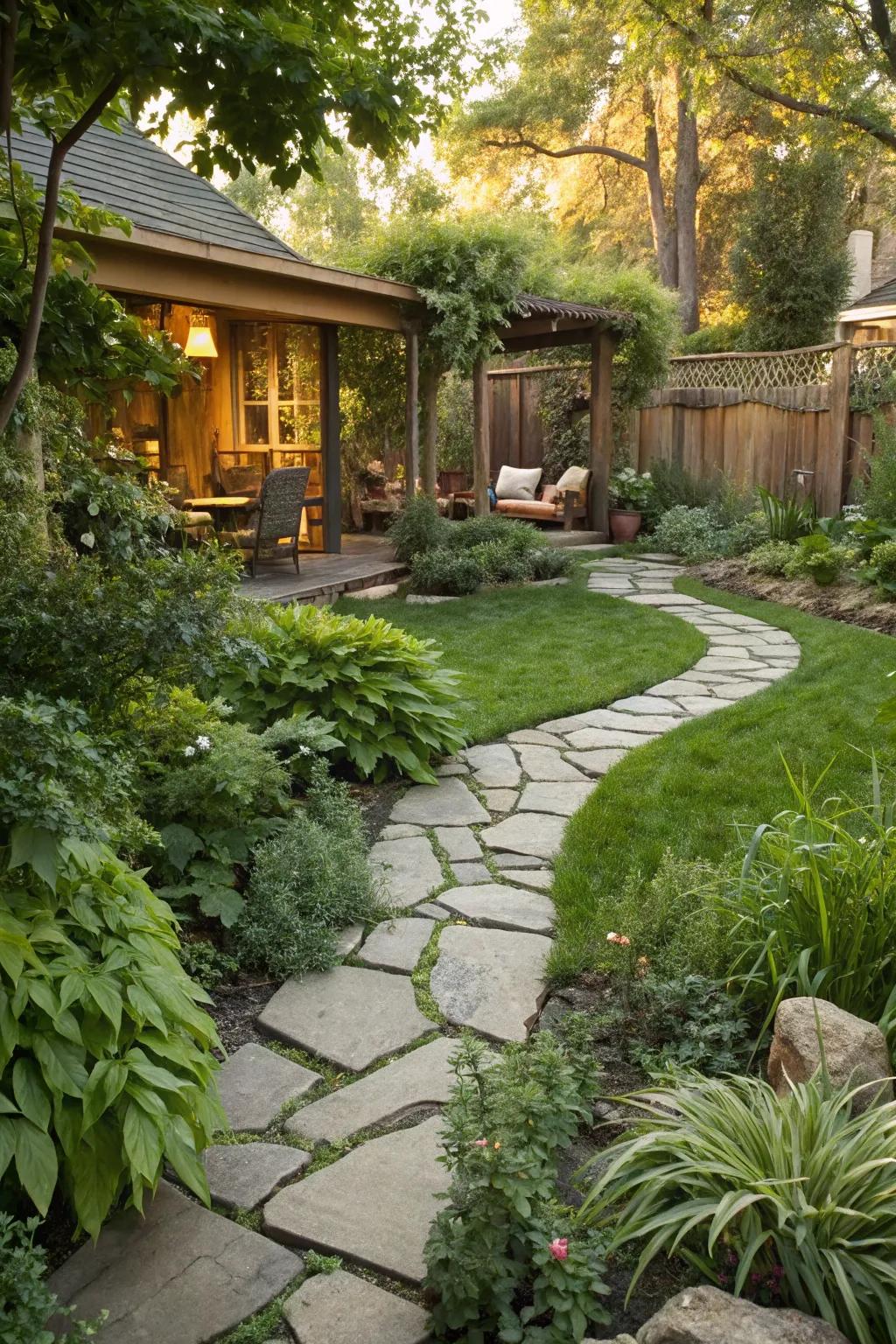
There’s something so inviting about a pathway that feels as if it belongs—edging and all. These little transitions are where magic happens in garden design.
To effortlessly unite your paths and borders, consider these two smart moves:
- Edge pathways with a flexible material like rubber or stone that lets your design flow naturally.
- Set solar lights right at the edge for both safety and sparkle at dusk.
Sometimes the simplest touches create the strongest sense of welcome.
These products might help:
Could Raised Bed Borders Be the Secret to Effortless Gardening?
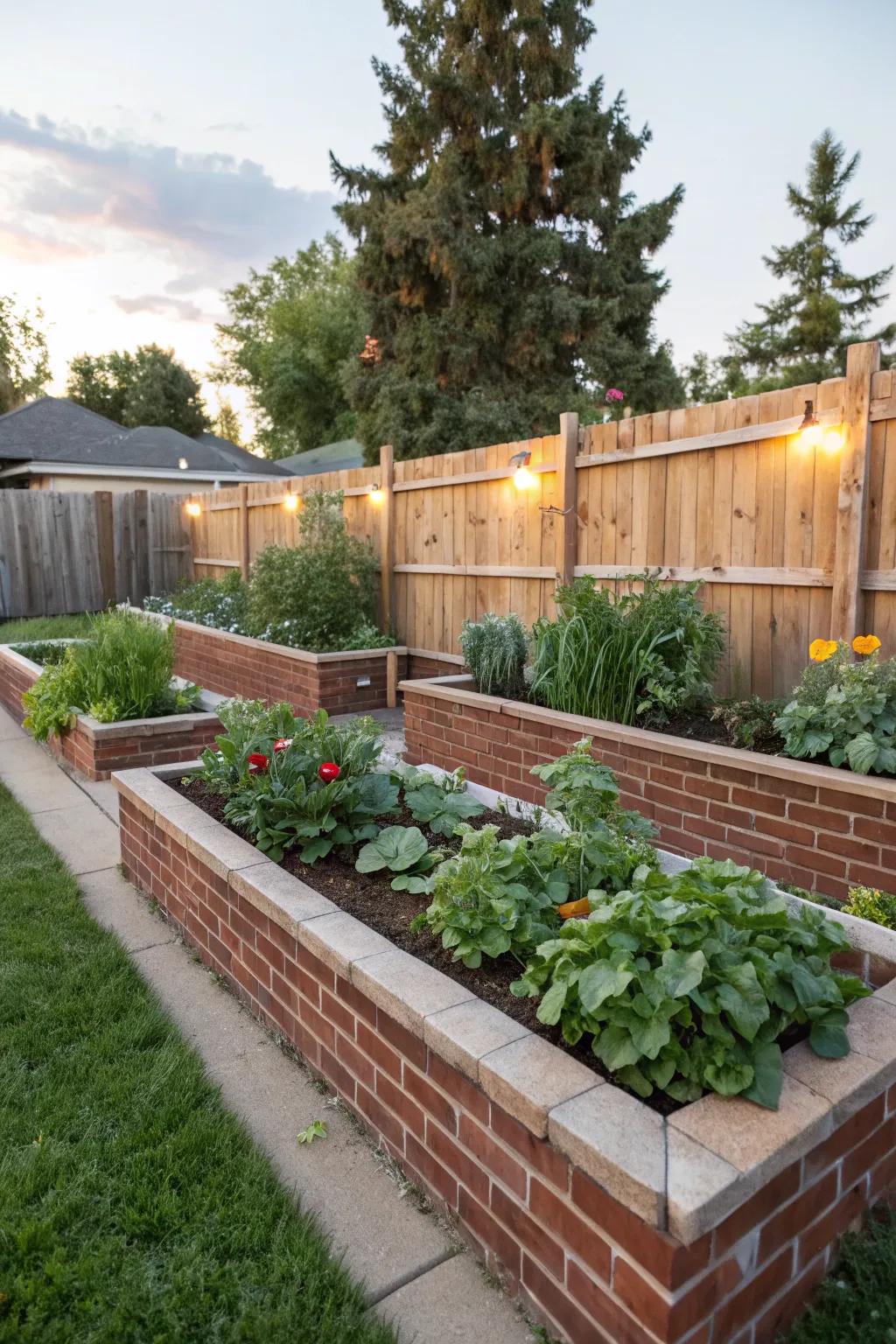
Raised bed borders aren’t just a pretty face—they’re a hardworking hero in any garden. By lifting your soil above ground level with brick or stone, you create better drainage and more clearly defined planting areas.
It’s amazing how professional your landscape looks when you elevate even a small garden corner. Try starting with just one bed and expand as you fall in love with the results.
Sometimes the smallest changes create the biggest impact.
Try these:
Whimsical Weaving: Why Willow Wins for Garden Edging!
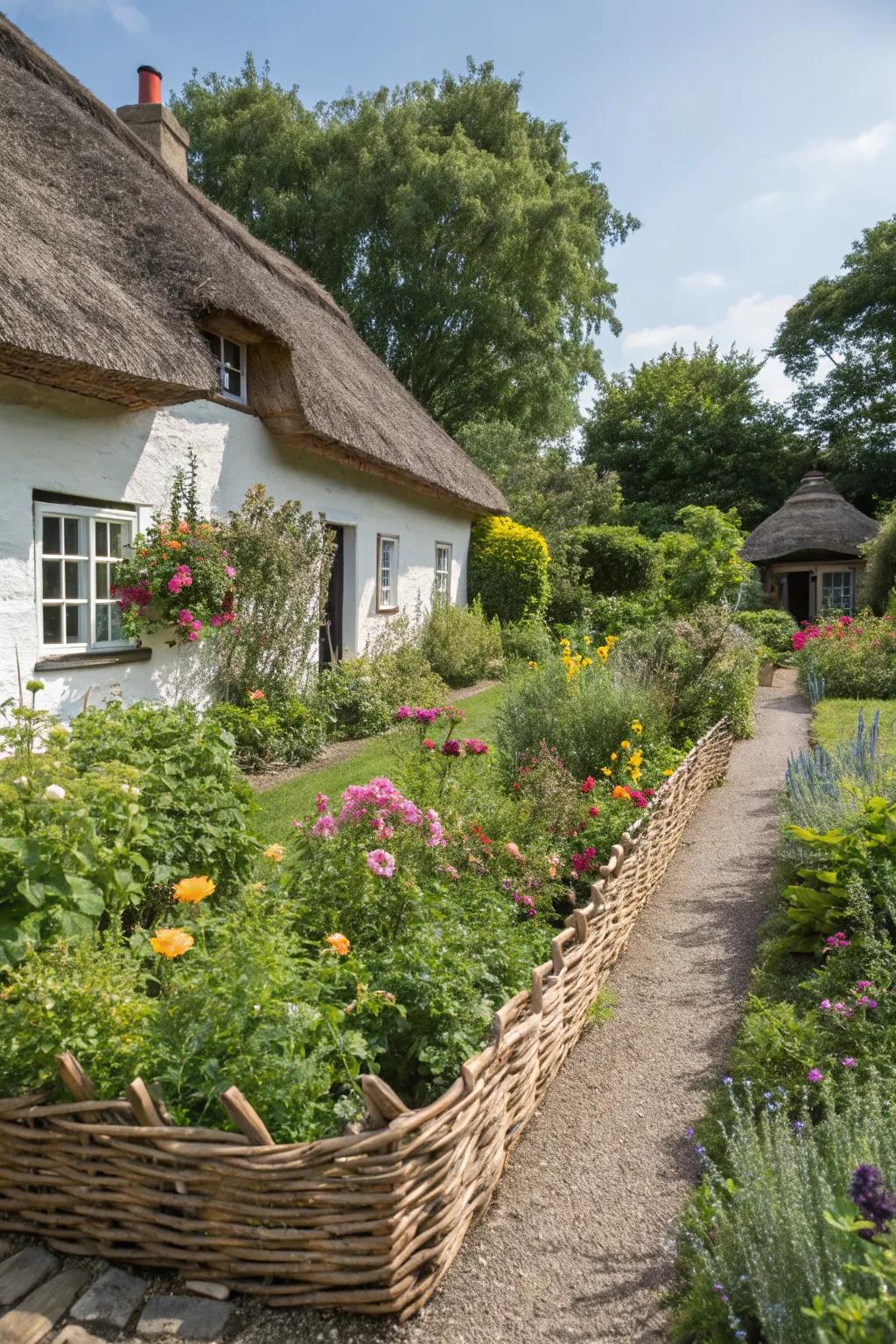
There’s a storybook spell cast every time I edge a path or bed with woven willow. Its rustic lines and subtle bends practically hum with old-world wisdom, bringing cottage-garden romance to even the smallest spaces.
Here’s why I often reach for willow when clients want their gardens to feel organic, warm, and timeless:
- It blends beautifully into any landscape, feeling both structured and spontaneous.
- Willow’s flexibility means you can curve and weave it into any shape you dream up.
- Installation is refreshingly simple—even for beginners.
- As a sustainable, biodegradable material, willow gently returns to the earth over time.
I’ll never forget when Anna, a newly-retired teacher, asked me to transform her tired backyard into a retreat. The moment we installed woven willow edging, her garden suddenly felt like a page out of a childhood fairytale.
Isn’t it time your garden told a story too?
Check if these fit your needs:
Pennywise & Pretty: Budget-Friendly DIY Garden Edging
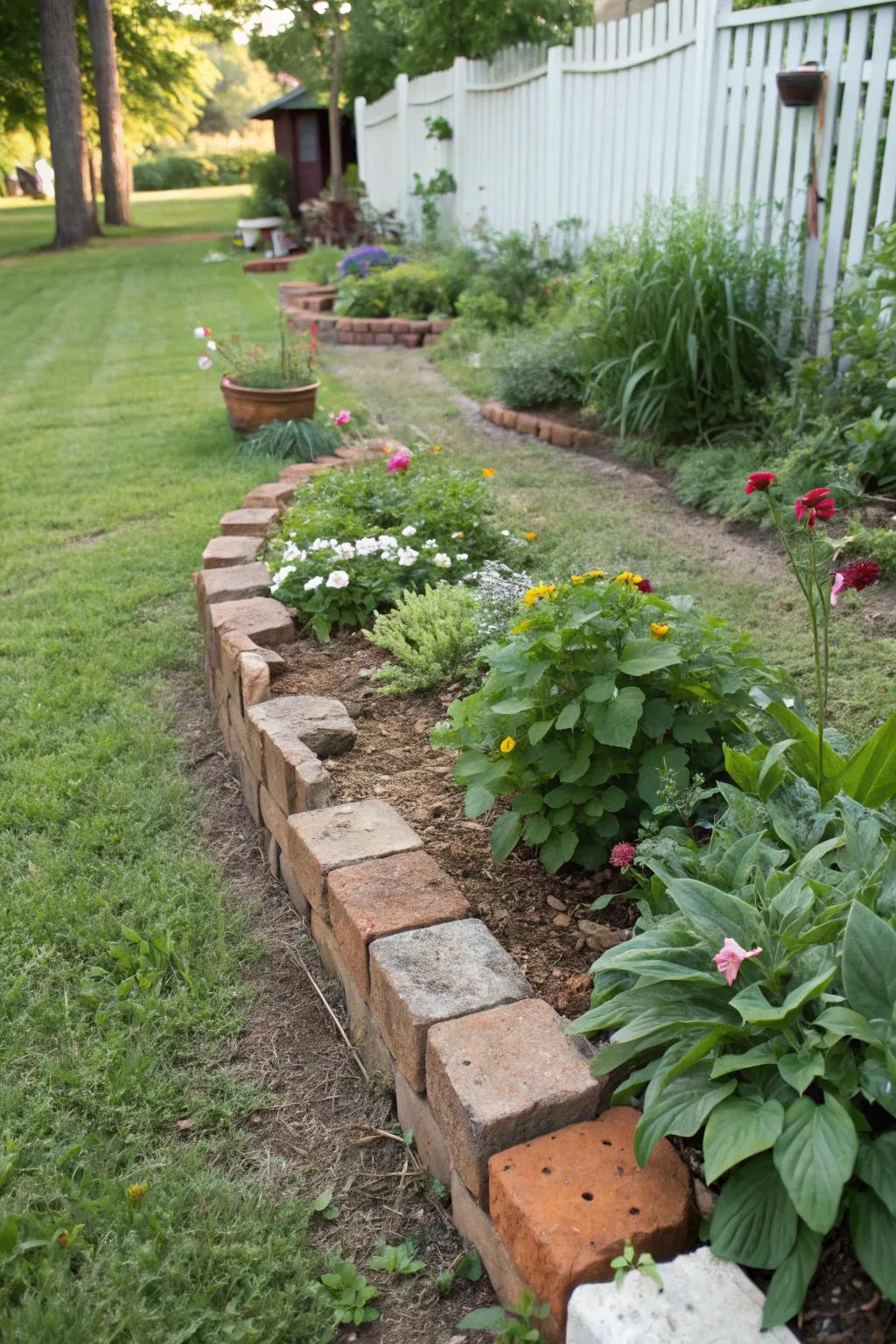
If you’re itching to bring a touch of personality to your garden without spending a fortune, let me assure you—budget-friendly DIY edging is your new best friend.
You don’t have to sacrifice style for savings. In fact, some of the most charming garden borders I’ve seen (and helped create!) started with what others might call scraps: old bricks, reclaimed wood, even leftover tiles from a kitchen remodel. There’s creativity in resourcefulness—and I believe a little elbow grease goes a long way.
- Hunt for discarded bricks at local reclamation yards or online swaps.
- Lay down a base of landscape fabric before placing materials to keep weeds at bay.
- Use a reliable edging spade—your secret weapon for clean lines and easy installation.
Don’t be afraid to mix and match materials for a wonderfully eclectic look!
I once worked with Melanie, a teacher who wanted a playful garden on a budget. Together, we salvaged bricks from a nearby building site (with permission, of course), and unleashed our imaginations. The finished edge ran in a gentle wave, guiding the eye through cheerful daffodils. Melanie told me later that it made her garden feel like a fairytale—proof that a little ingenuity and sweat equity can yield magical results.
Ready to get your hands dirty? Your dream border is just a weekend away.
Possibly helpful picks:
Shell Out Some Style: Seashell Edges That Wow!
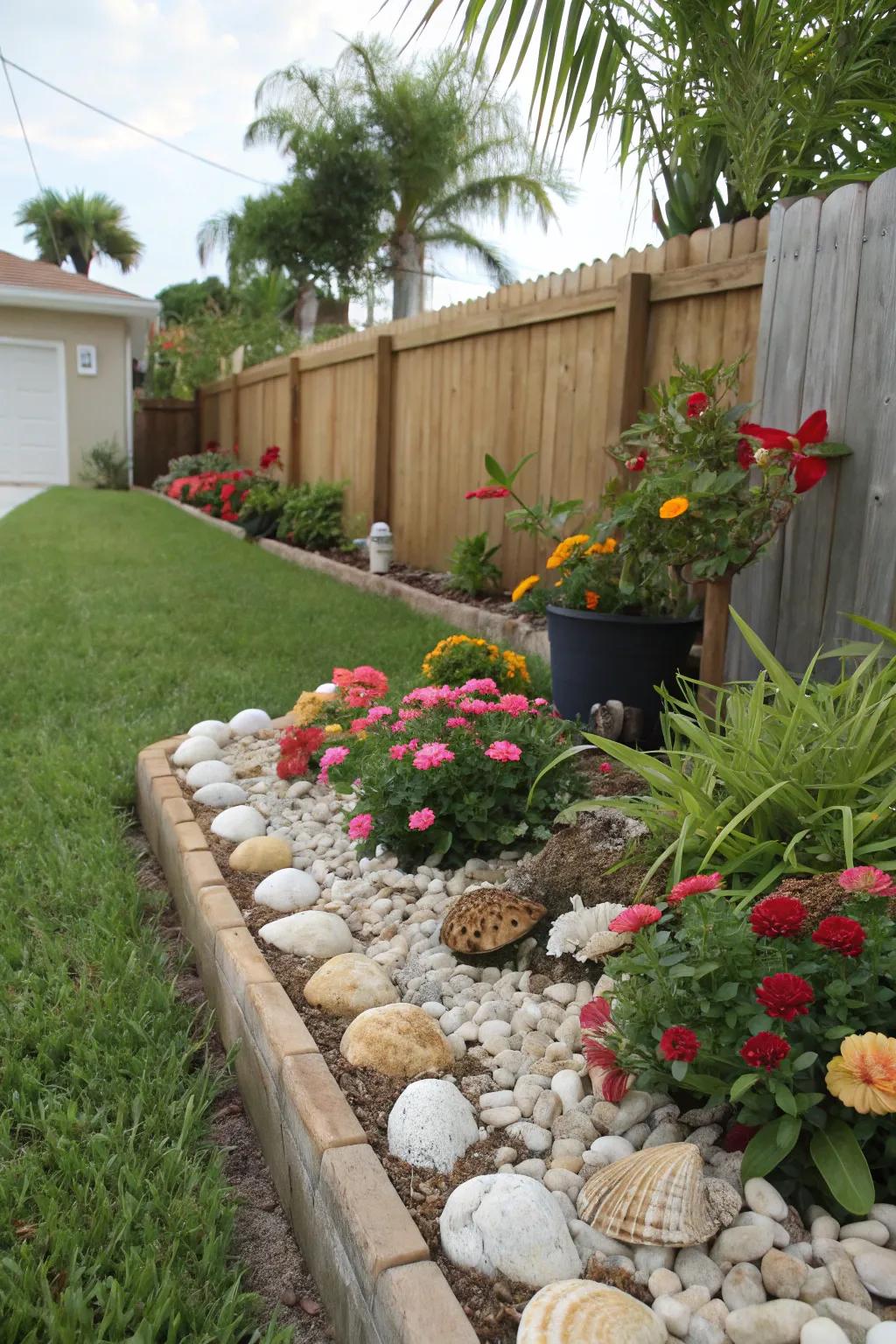
There’s something magical about walking along a garden bed edged with seashells. Each shell seems to whisper stories of sunlit shores and salt-kissed afternoons, instantly transforming your landscape into a coastal hideaway—and it’s simpler to achieve than you might think.
Why seashells? For one, they add a dreamy, storybook texture, catching the light and sparking childhood memories of beachcombing. Seashell edging offers gentle curves and a bright, reflective quality that can lift shadowy garden corners. If you’re aiming for whimsy, seashells deliver in spades—but they also quietly suggest intentionality and care. Isn’t that lovely?
If you’re considering this unique edging, here are my favorite practical steps to make your vision a breeze:
- Gently nestle shells into a thin trench for stability and a tidy look.
- Alternate shell shapes and sizes for a naturally eclectic border.
- Rinse your shells well, especially if you’ve collected them yourself, to prevent lingering sea scents!
A garden I designed for my clients, Marissa and Cole, truly came alive the day we finished their seashell border. Marissa’s eyes lit up—she could almost feel sand between her toes again. That’s the beauty of gardens: they transport us.
Ready to let your landscape sweep you away?
A few helpful options:
Yearning for Tuscany? Terracotta Tiles Transport You There!
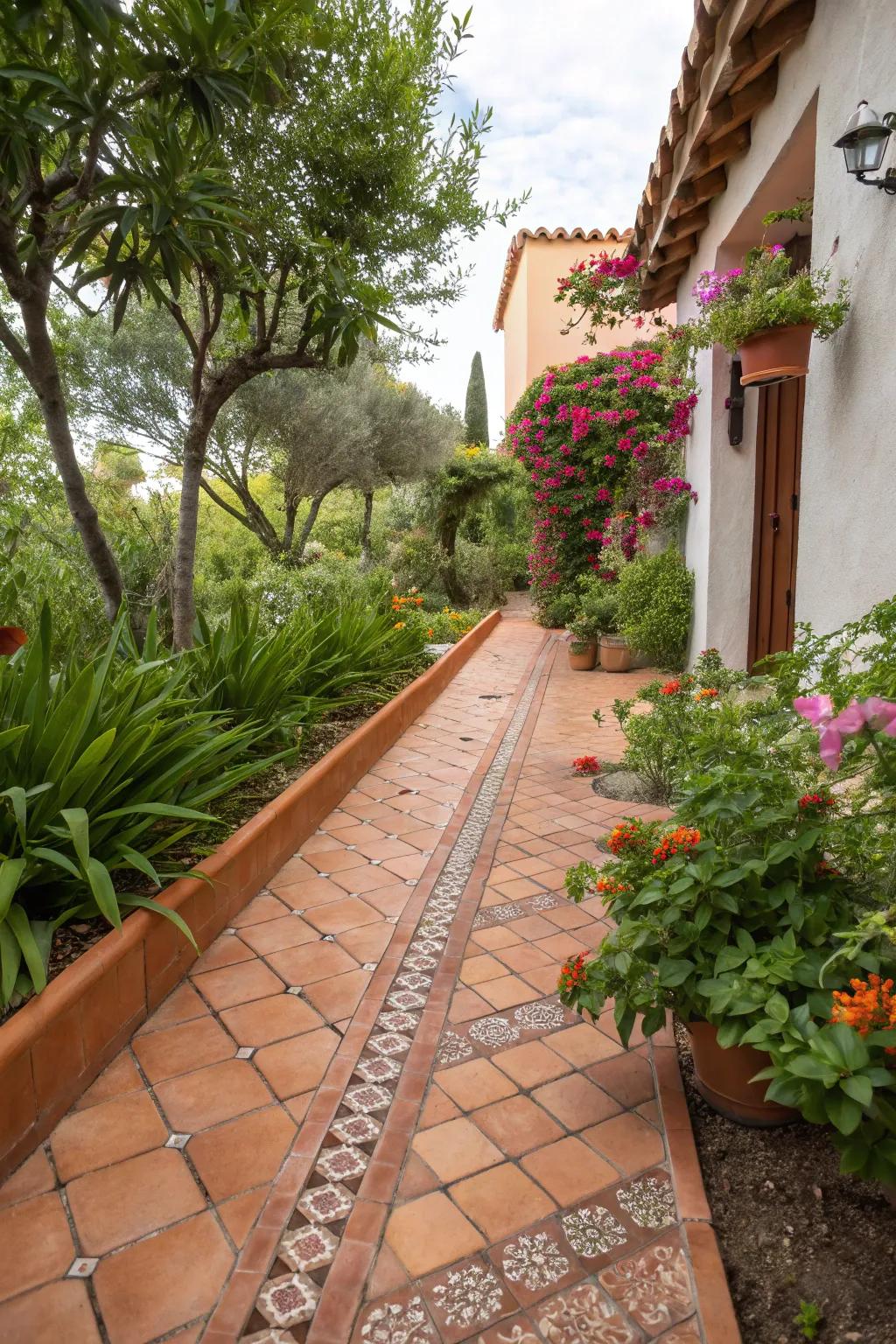
Terracotta tile edging instantly fills a garden with Mediterranean allure—the kind of soul-warming ambiance you’d find wandering a sunlit terrace just after a summer rain. The rich, earthy tones not only provide definition, but they also exude warmth and rustic elegance in a way that few materials can.
Ready to lay your own path to paradise? Start by sketching out your intended border—straight lines feel neat and classic, but gentle curves lend an almost poetic charm. As you lay each tile, nestle them firmly into the soil for stability. Here are my favorite touches that bring extra magic to terracotta borders:
- Mix tile sizes for a textured, artisan look.
- Pair tiles with low herbs, like oregano or thyme, for scent and softness.
- Use a layer of sand underneath to improve drainage and ease installation.
- Try alternating upright and flat tiles for playful contrast.
- Edge with pea gravel for a crisp finish.
I once worked with the Thompsons, who wanted to evoke their honeymoon memories abroad. With terracotta tiles lining their winding paths, their entire garden seemed to hum with nostalgia and new possibility.
How will you let your edges reflect your favorite getaway? Sometimes, it’s the smallest details that make your garden feel like a world apart.
Useful items to consider:
Why Try Plastic Edging?
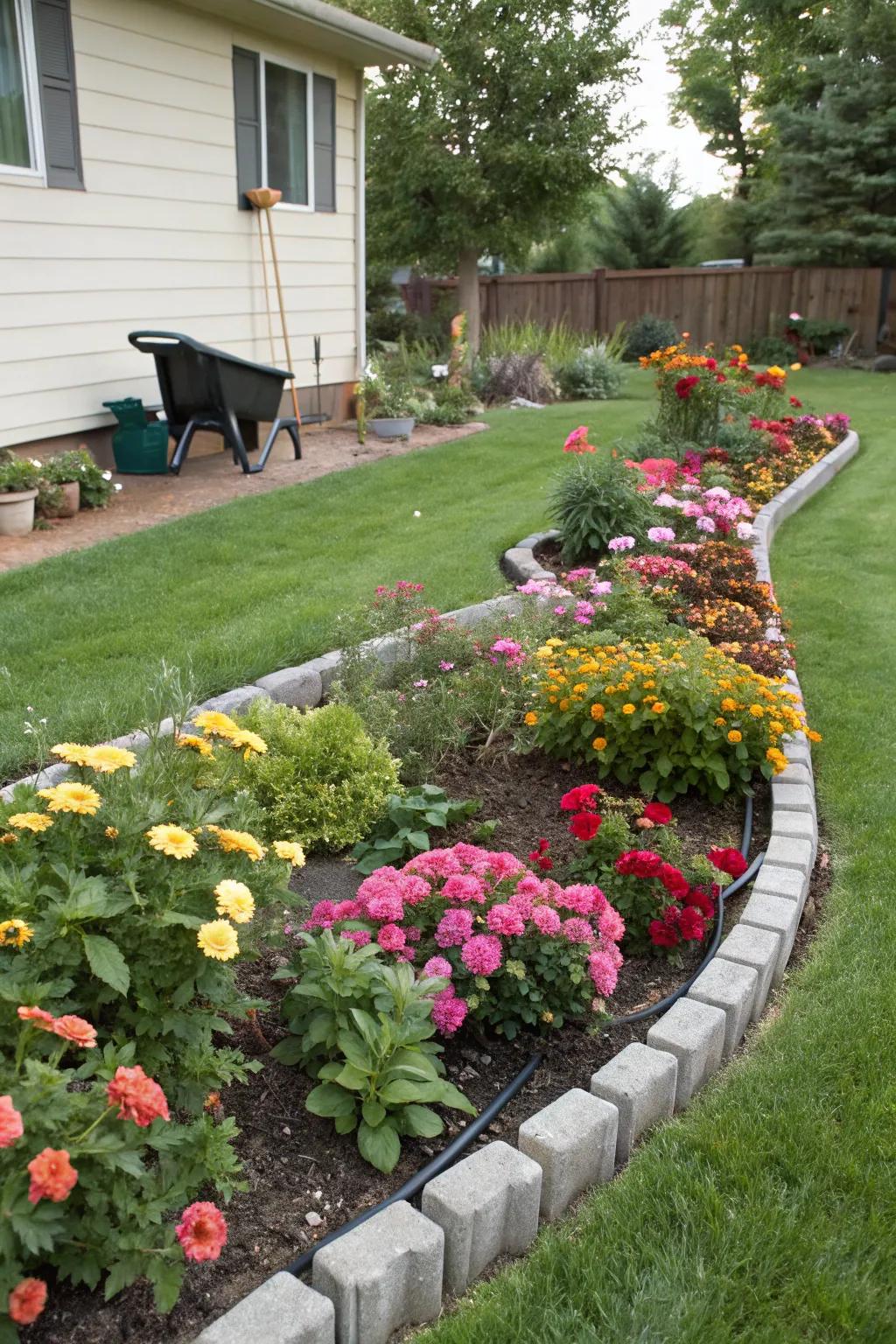
Don’t underestimate the humble plastic or rubber edging! I’ve seen even the most chaotic beds come into perfect focus with this simple touch. It’s flexible, affordable, and quick to install—ideal for anyone who loves a crisp, modern line but not a lot of fuss.
Sometimes, less really is more.
Give these a look:
Metal Edge Sophistication: Clean Lines, Modern Shine
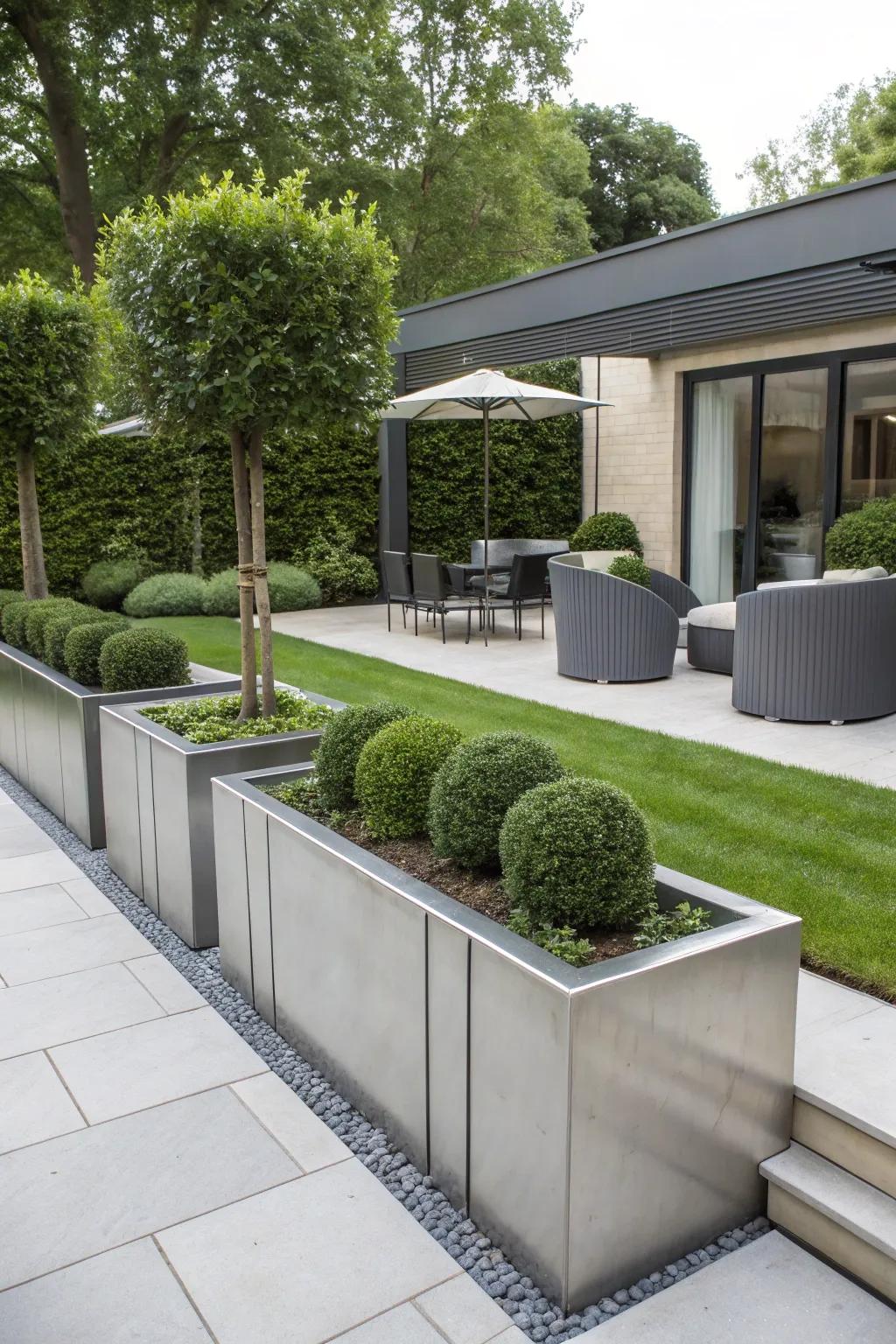
If your garden style leans toward the contemporary, metal edging might just be the sleek hero you didn’t know you needed. I adore how its neat, crisp lines frame plantings and walkways, turning the ordinary into something special.
A steel or aluminum border stands up to the elements and resists warping over time—a real workhorse behind the scenes. I always recommend it for modern gardens where that industrial touch elevates the entire look.
Versatility is the name of the game with metal. When I partnered with the Robinsons, who loved a blend of minimalism and greenery, we used brushed aluminum as a subtle divider between their lush hostas and a pebble pathway. It was a match made in garden heaven—easy to install, low-maintenance, and oh-so chic! Metal’s ability to “draw a line in the sand” (or soil!) is both practical and beautiful. Why not give your garden edges a glossy upgrade?
A few suggestions:
Tire-Inspired, Color-Required!
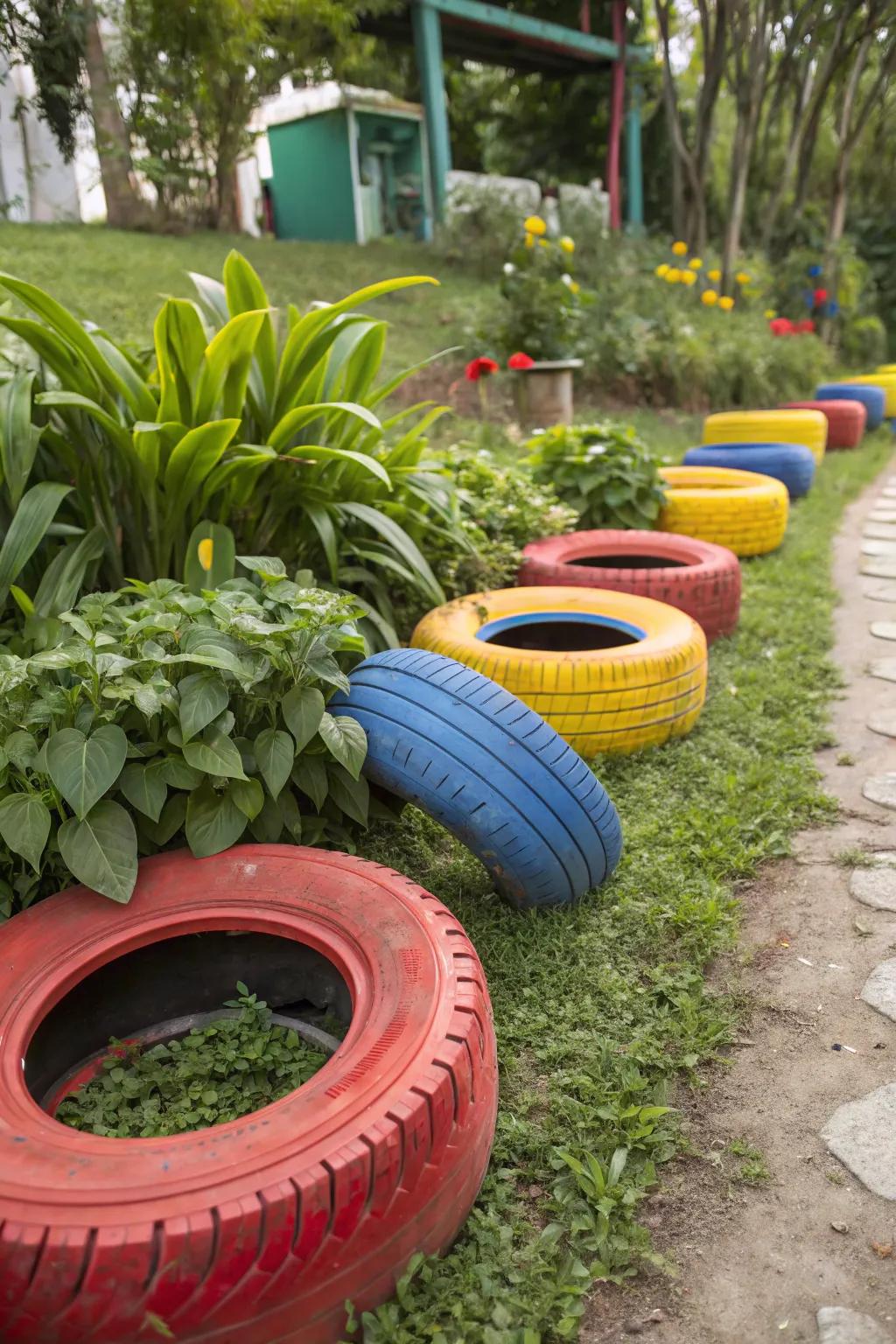
You don’t need to break the bank—or the planet—to create borders that pop.
Recycled tire edging is the ultimate in playful, eco-friendly creativity.
Just a splash of outdoor acrylic paint and old tires transform into cheerful garden accents.
Choose bold colors or subtle tones—the choice is yours! Just remember to go the extra mile: a little prep and weather-resistant paint keep everything looking fresh. If you ever wanted to think outside the garden box, now’s your chance.
Sometimes, the best ideas really do roll right in!.
Possibly handy products:
Gabion Basket Brilliance: Stones, Style, and Substance

Ready to shake up your garden borders with something extraordinary? Gabion baskets—those stylish wire cages filled with stones—aren’t just for highways or commercial landscapes. These bold, architectural elements have found their way into home gardens, offering a striking blend of raw texture and clean lines.
The effect? Absolutely eye-popping.
I once helped Daniel and Priya create a boundary that solved both a practical problem and a style dilemma. Their busy garden needed a solid edge (they have two energetic dogs), but they also loved minimalist, contemporary design. Gabion baskets were our answer—each one carefully filled with local river stones, creating a natural-meets-urban vibe that felt both grounded and modern.
Not sure if gabions are for you? Consider these advantages:
- Gabion baskets adapt to curves and corners, so they’re perfect for both straight and meandering beds.
- The see-through mesh lets plantings peek through, softening the structure while keeping things tidy.
- They double as retaining walls or raised beds—ideal for sloped gardens or spaces that need definition.
When working with clients, I often recommend adding a layer of landscape fabric underneath the baskets to keep weeds at bay. And don’t be afraid to play with what goes inside—river cobbles, angular granite, even bits of colored glass for a punch of personality. Mixing stone sizes adds visual texture too.
Imagine a border that looks like a work of art, but stands up to the elements—and your lifestyle.
If you’re craving a garden that feels both timeless and on-trend, gabion edging might just be the secret ingredient you’ve been searching for.
Products that could assist:
Growing Beauty
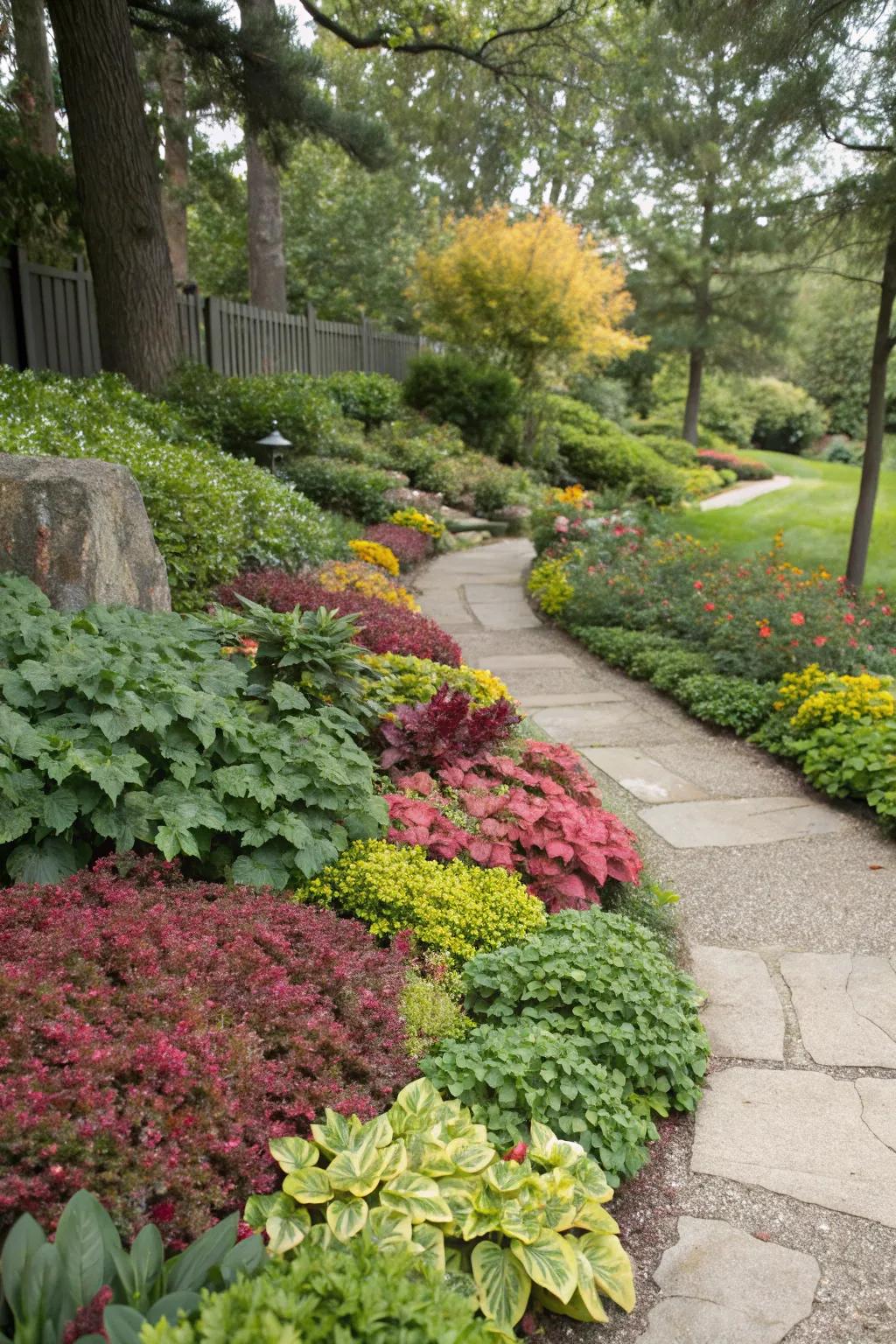
Planting a living border is more than just landscaping—it’s nurturing life itself. Choose low-growing perennials or herbs and watch as your garden edges become a canvas of shifting colors and textures.
If you’re looking for a natural, ever-changing border, ask yourself—which plants would bring you joy season after season?
Sometimes, the best garden border is one that’s always in bloom.
A few things you might like:
Concrete Edging Elegance
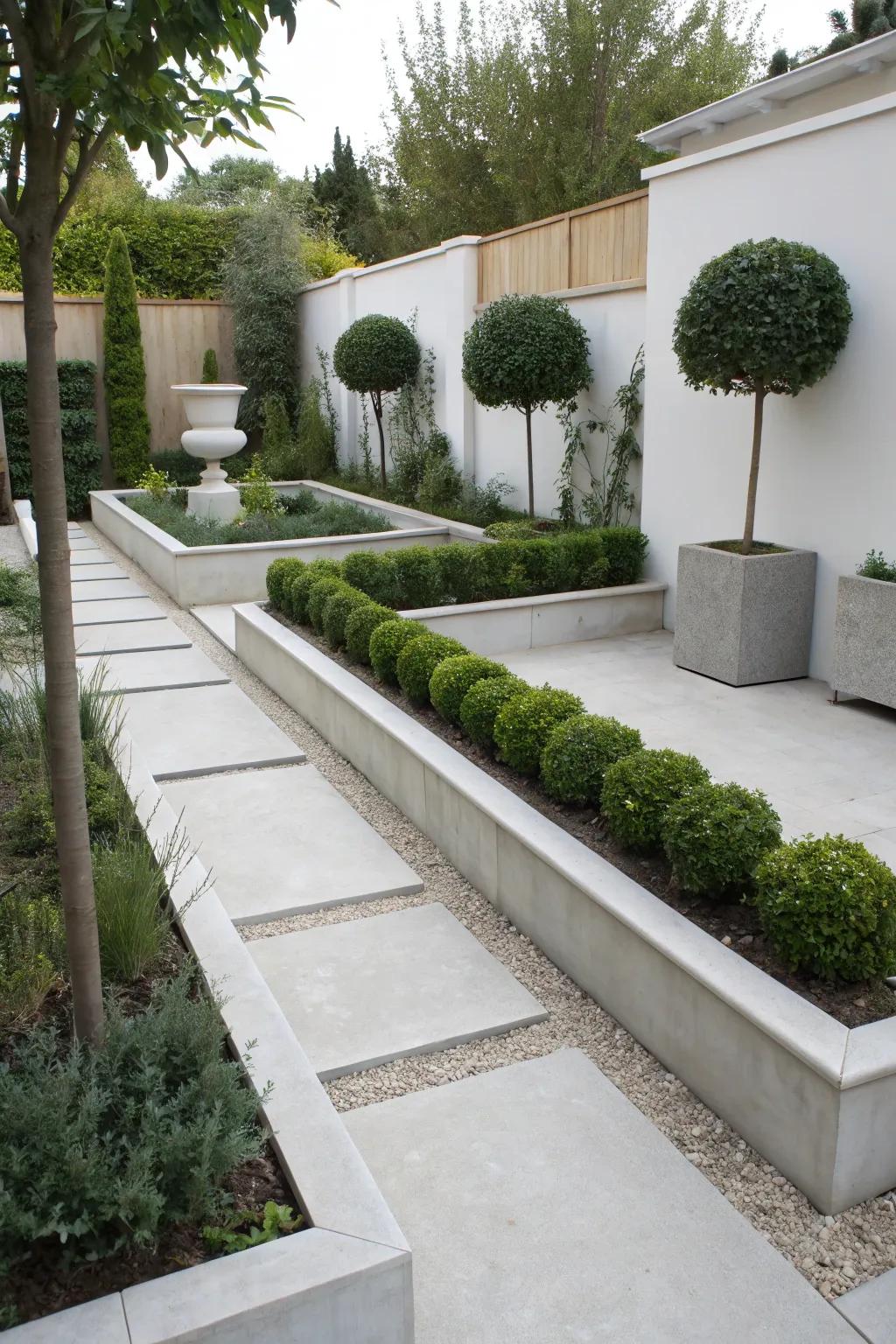
For durability and style, concrete edging stands strong. It’s my go-to for creating clean, minimalist lines in my garden.
Some handy options:
Whispering Bamboo, Lasting Calm
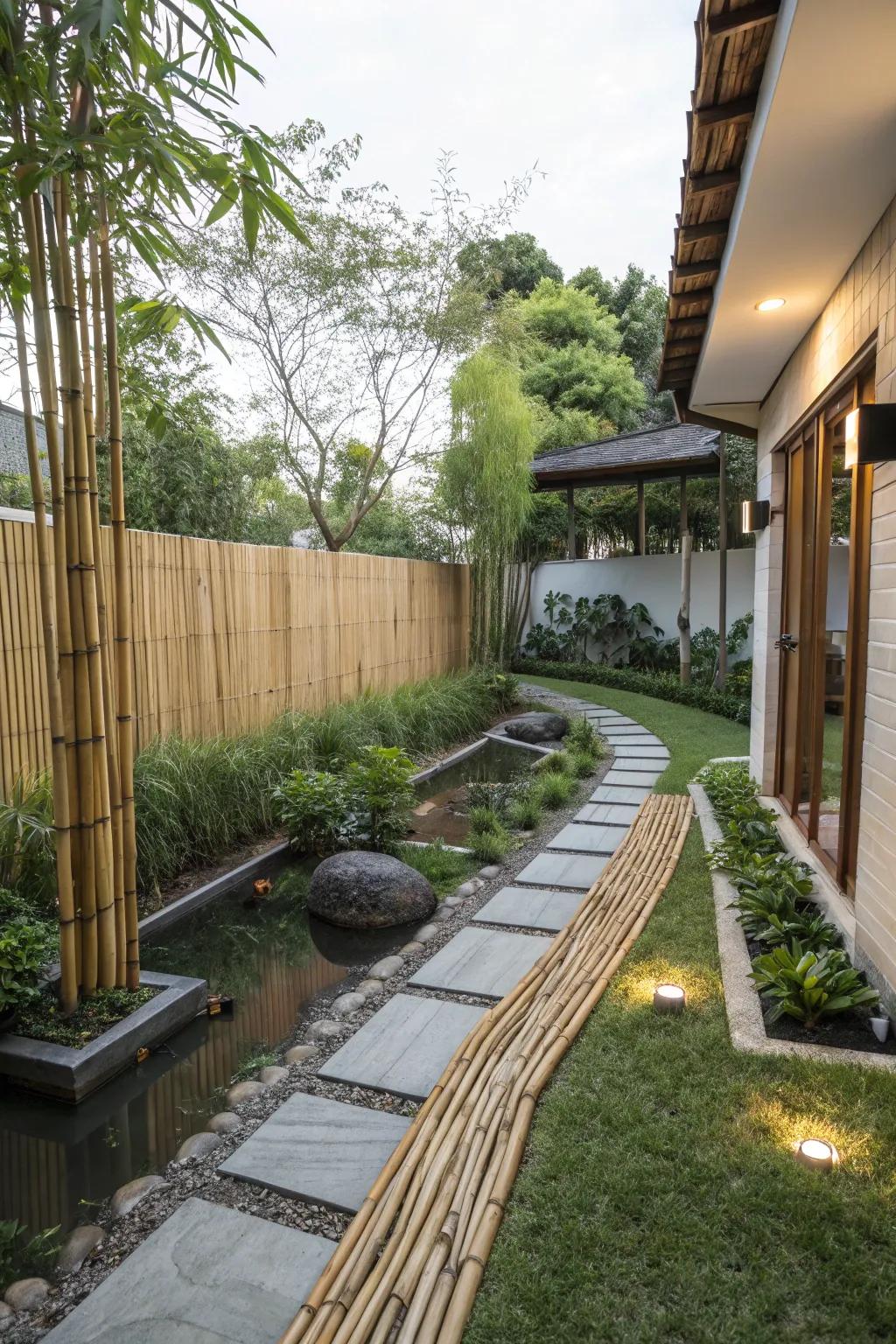
Isn’t there something wonderfully serene about bamboo? Its soft rustle in the breeze instantly washes a sense of calm over any garden space. Bamboo edging is both eco-friendly and visually soothing—perfect for cultivating a meditative retreat among the greenery.
Let your garden exhale with every bamboo whisper.
A few choices to try:
Planks with Panache: Modern Garden Edging, Reimagined
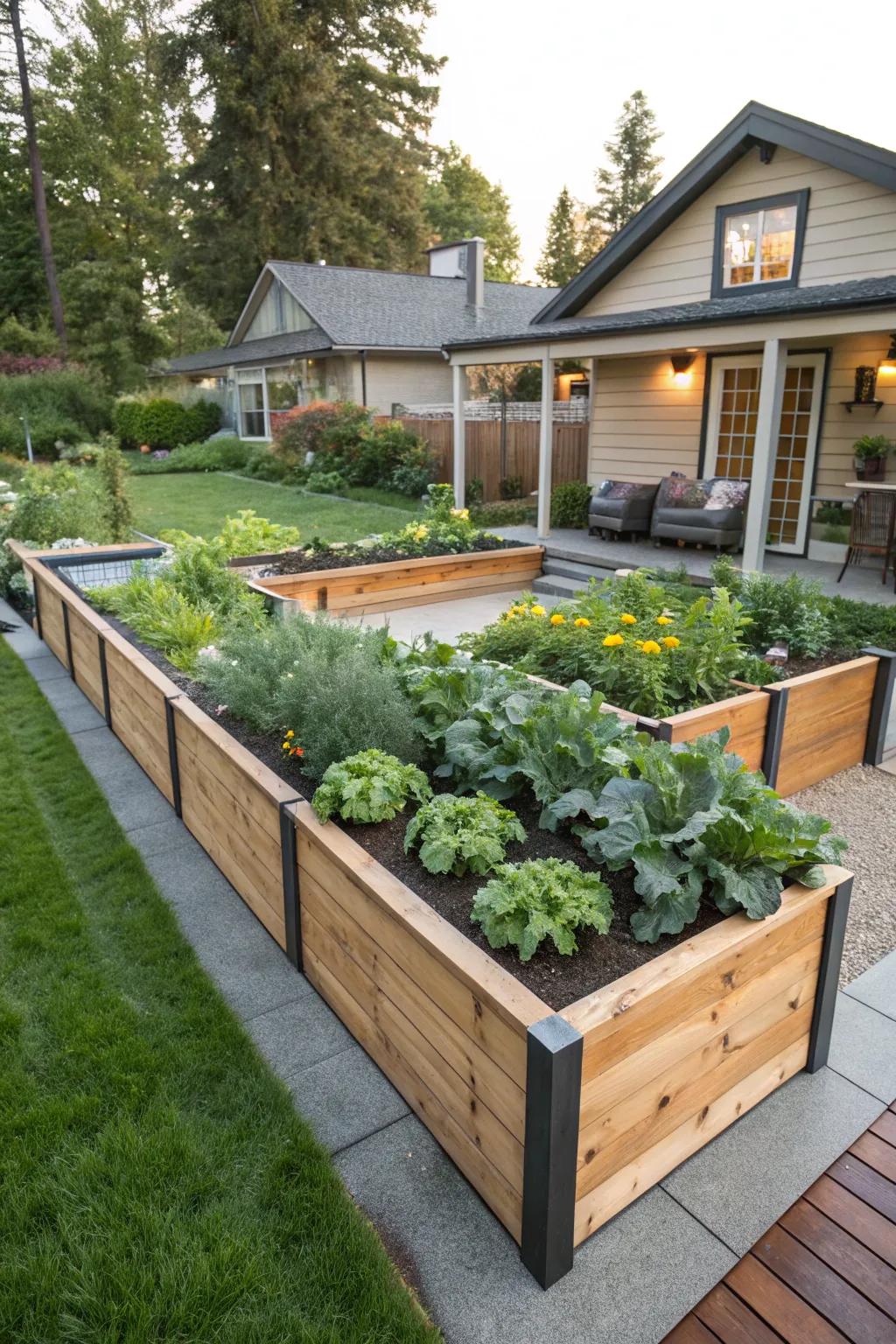
If you’re looking for a way to give your garden edges some swagger, why not try wooden planks? There’s something irresistibly crisp and contemporary about straight, clean wood lines bordering your garden beds.
Just picture it: natural or painted planks slicing through lush greenery, instantly upgrading the vibe from ordinary to extraordinary.
When I worked with Zoe, a client who craved a balance between minimalism and natural beauty, we settled on horizontal wooden plank edging for her vegetable beds. She wanted sophistication but also needed practicality for her busy family. We went with a subtle ash-grey stain—modern, yet still warm—and spaced the planks just enough to let herbs spill over.
Safety first! Whenever you install wooden plank edging, keep these essentials in mind:
- Treat your wood to withstand rot and insects—especially if you’re using it near edible plants.
- Double-check that edges aren’t rough or splintered, especially in high-traffic areas.
- Use strong, rust-proof stakes to anchor planks tightly.
- Consider height: low for visual flow, tall planks for structural definition.
Isn’t it amazing how a simple material can make your whole garden pop? That’s the magic of wooden plank edging: sleek, modern, but endlessly adaptable.
May just do the trick:
Stone Story: Let Nature Do the Talking
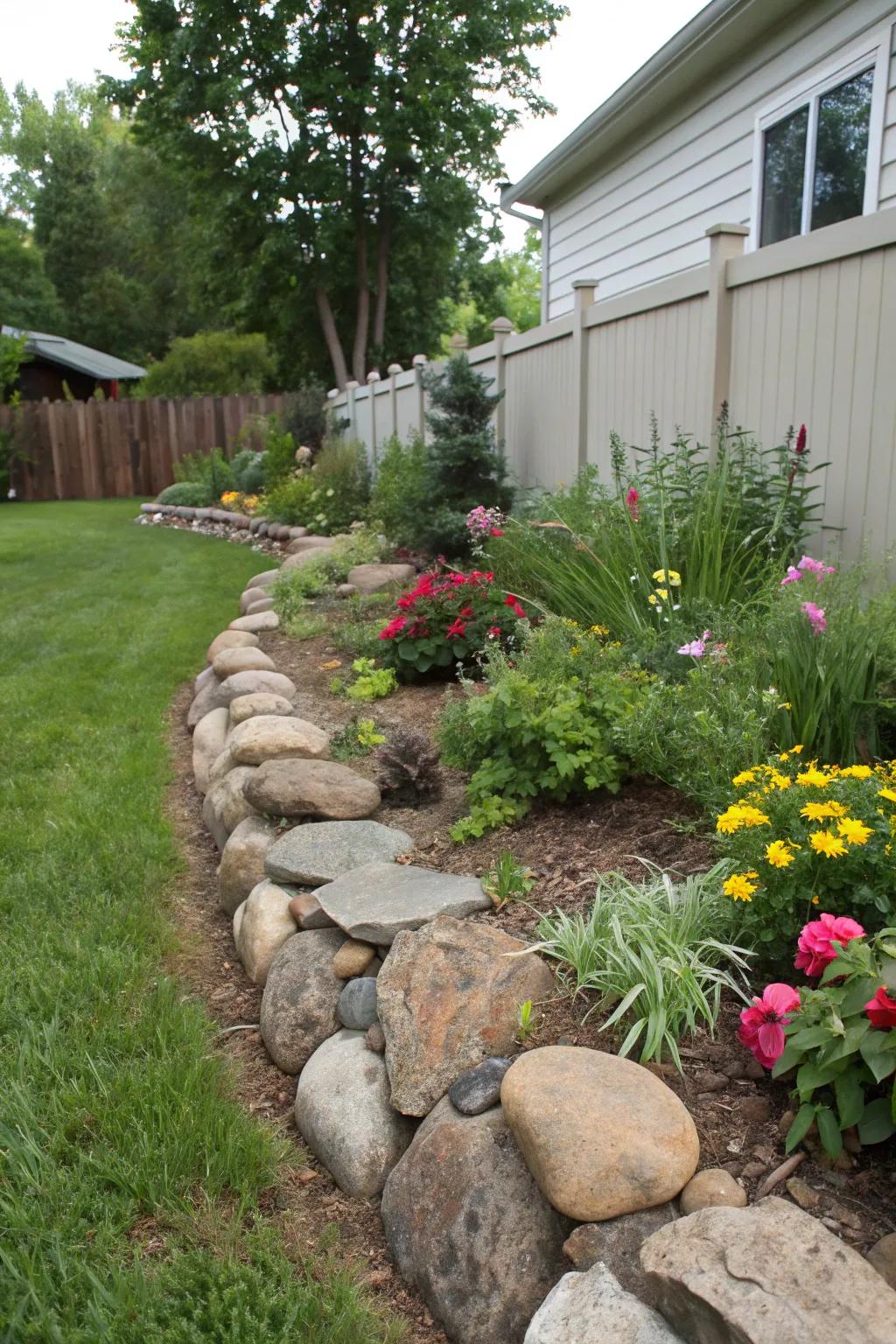
If your garden craves a whisper of the wild, you can never go wrong with stone edging. There’s an earthy solidity to natural stones and river rocks that always makes my heart sing—and they pair beautifully with overflowing greenery or a tangle of herbs.
- Lay stones of different sizes to mimic nature and keep your border interesting.
- Angle your stones slightly toward the garden bed for extra stability and a polished look.
- Don’t forget to tuck in moss, creeping sedum, or small succulents between stones for that lived-in softness.
- Choose colors that bring out the best in your plants—gray for cool, calming vibes or tan for sun-warmed charm.
Let your stones settle, and you’ll find your entire landscape feels more grounded—in every sense of the word.
Check these products out:
Bed Beauty: Layered Looks for Lasting Impact
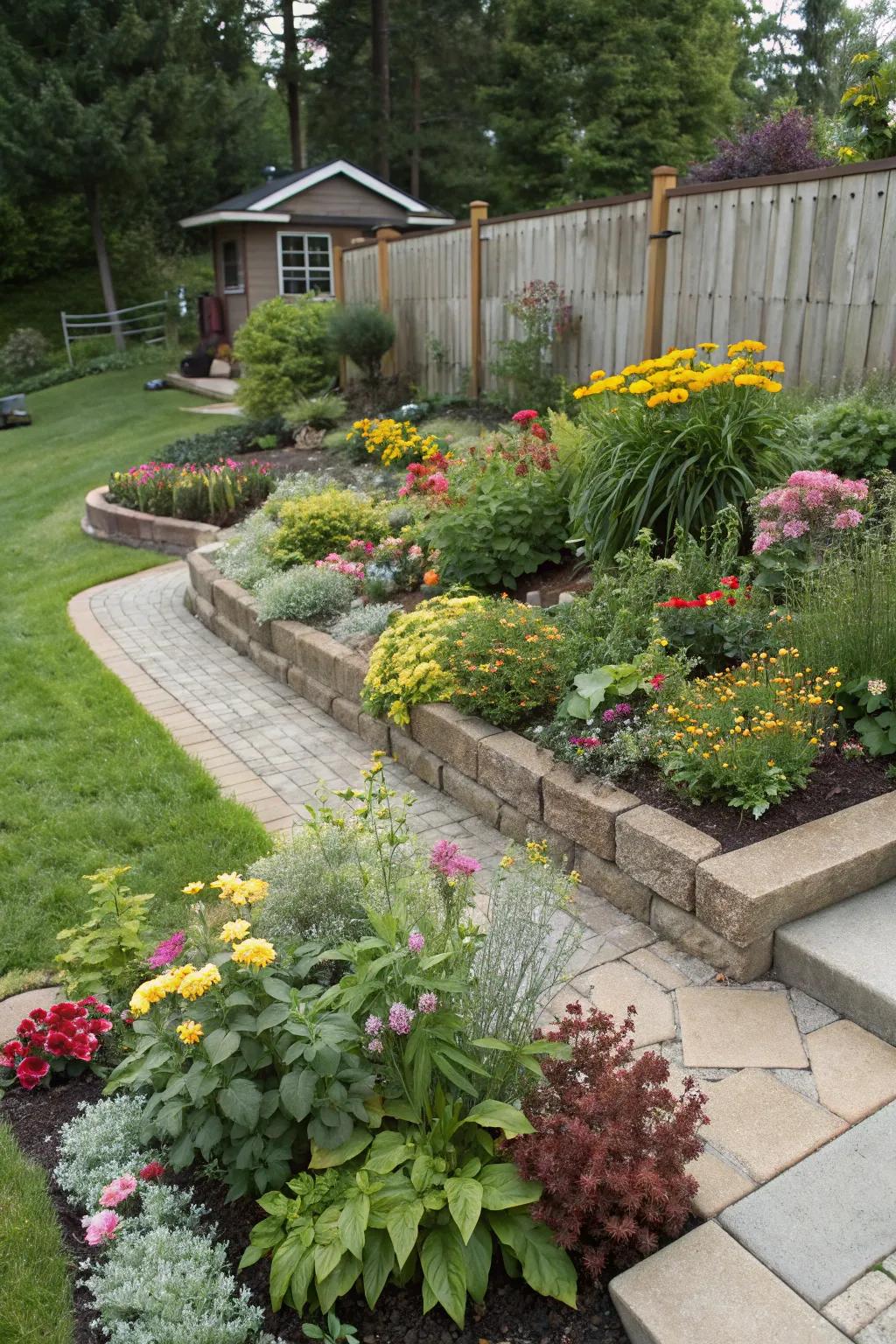
A well-layered flower bed is like a patchwork quilt—it weaves together colors, heights, and textures for a living tapestry that draws the eye and nurtures the soul.
Layering your beds adds dimension, making even a small corner feel lush and abundant. It’s the trick I reach for when a client’s garden seems flat or underwhelming. By arranging plants so that tallest varieties fade into delicate groundcovers, you create visual rhythms that guide visitors through your space.
Here are two of my favorite tips for getting those layers just right:
- Start with a backbone of perennials or shrubs, then build forward with mid-height bloomers and finally tuck in soft, trailing plants at the edge.
- Mix leaf shapes and flower forms as much as colors—think spires with mounds, or lacy foliage against broad leaves—for instant texture and intrigue.
I once worked with Clara, a retired teacher who wanted her sloped backyard to feel more dynamic. We created tiered beds by gently grading the soil and using flexible edging to hold each level. Clara loved playing with color—her purple salvia, golden yarrow, and blue fescue turned the whole bed into a painter’s palette. Every time I visit, her garden looks a little different, but always full of life.
Remember: the best gardens are layered with intention, joy, and a touch of surprise.
A few relevant products:
Curved Brick, Classic Chic
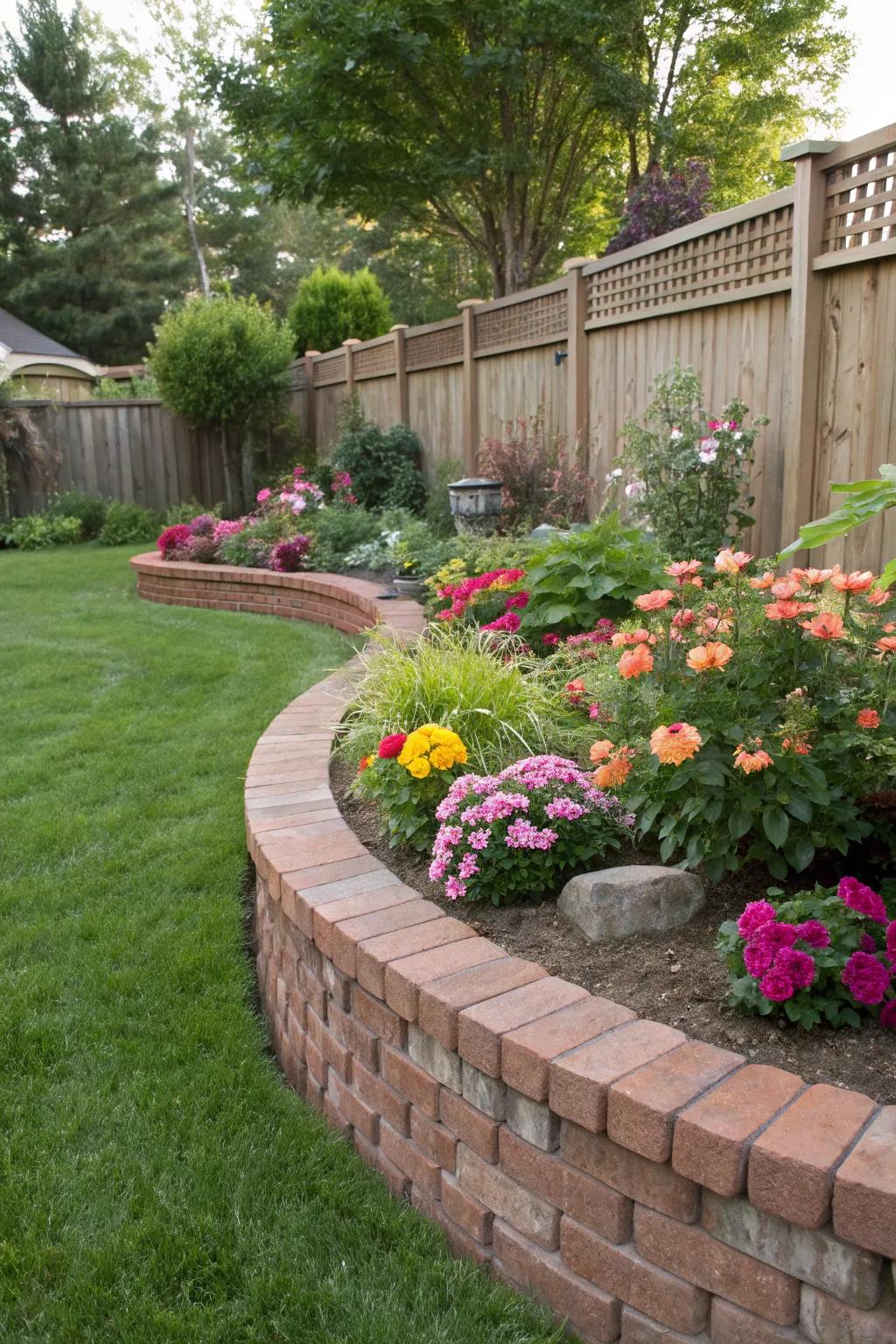
There’s something undeniably timeless about a softly curving path lined with bricks—it’s like rolling out the red carpet for your garden. I always tell clients that brick edging is the chameleon of landscape design: warm, structured, and endlessly adaptable. It draws the eye, subtly organizing your space while whispering a hint of old-world romance.
If you’re ready to give your greens a grand entrance, here’s how I guide most homeowners through the process:
- Map out your curves with a garden hose or rope first; this lets you visualize the shape before you dig in.
- Use a sharp edging shovel to cut clean, confident lines for your bricks. Aim for consistency, but let the curve feel natural—not forced.
- Tap bricks gently into place, making sure they snuggle up tightly. Fill small gaps with sand or fine gravel for a crisp, professional finish.
Sometimes, a gentle arc in a path can turn a walk into a journey.
One of my favorite projects was with Emily and George, a couple who wanted their entryway to feel welcoming without being fussy. We mapped out a winding curve along their perennial beds; Emily sprinkled creeping thyme between the bricks for a fragrant touch, while George took pride in hand-tapping every brick. The result? A garden that feels both curated and completely personal.
Give your landscape a line that tells a story—you’ll be amazed at how much character a simple, curved brick edge can add!
Some ideas to consider:
Mix It Up! Edging That Pops and Dazzles
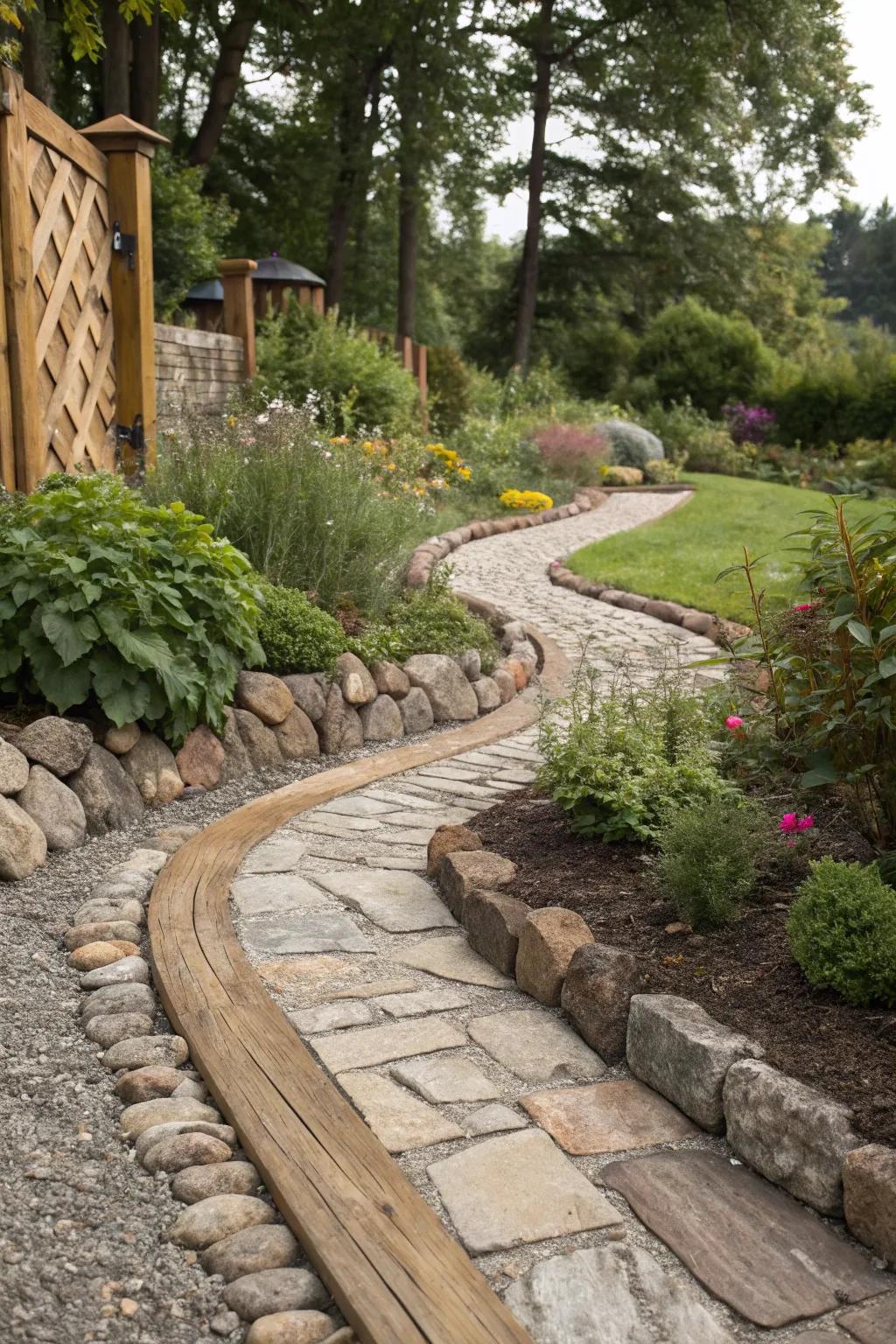
Why settle for just one material when you can have a garden border that tells a whole story?
Stone, wood, and metal—all together—bring texture, depth, and a playful spark to your paths or beds!

